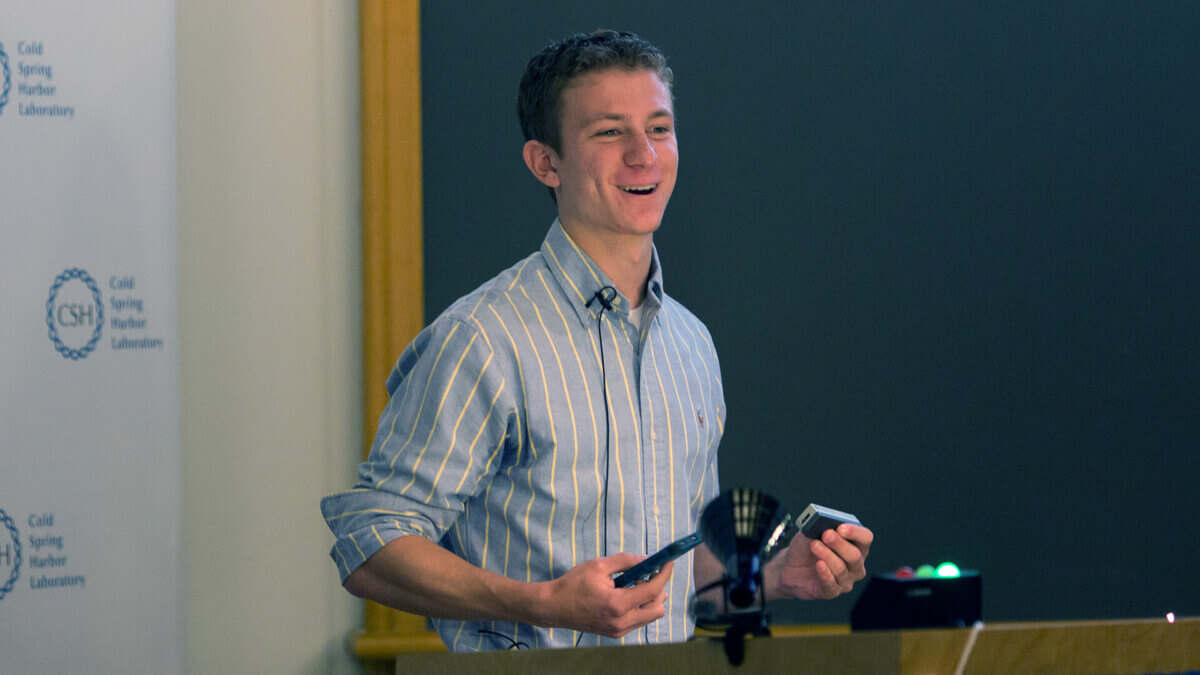
Aspyn Palatnick holding the world's first mobile genetics laboratory at Cold Spring Harbor Laboratory's 125th anniversary Open House. The combination of the new iPhone app, iGenomics, a DNA analyzer, and Oxford Nanopore's USB-sized MinION, a DNA sequencer, make genome analysis portable and accessible. (Credit: Cold Spring Harbor Laboratory)
COLD SPRING HARBOR, N.Y. — Move over Mr. Spock. A team from New York has created the world's first mobile DNA lab that can fit in your pocket. Much like the fabled “tricorder” scientific scanner from “Star Trek,” this iPhone app can help scientists study virus samples in the palm of their hands.
Researchers from Cold Spring Harbor Laboratory (CSHL) call the new app iGenomics. The device pairs a regular iPhone with a handheld DNA sequencer to create a portable genetic lab, much like the gadget in the science-fiction series of the 1960's.
The study says iGenomics can run completely on an iOS device, cutting out the need for bulky laptops and other pieces of equipment geneticists need in the field. Making the invention even more impressive, researcher Aspyn Palatnick programmed iGenomics over an eight-year period starting when he was just 14 years-old! At the time, Palatnick was a high school intern working in CSHL Adjunct Associate Professor Michael Schatz‘s laboratory.
Technology keeps getting tinier

Researchers developed the app to work with small DNA sequencing devices being created by Oxford Nanopore. Palatnick, who now works at Facebook as a software engineer, realized that technology was getting to the point where there was no reason DNA research could not become a mobile science too.
“As the sequencers continued to get even smaller, there were no technologies available to let you study that DNA on a mobile device. Most of the studying of DNA: aligning, analyzing, is done on large server clusters or high-end laptops,” Palatnick and Schatz say in a university release.
Schatz adds that scientists who study viral pandemics are “flying in suitcases full of Nanopores and laptops and other servers to do that analysis in the remote fields.”
The study says iGenomics also makes genome research more accessible and affordable for scientists. People using the app can actually AirDrop sequencing data to their colleagues, making it possible to do DNA analysis in remote locations, even in places without internet. The technology may also help astronauts perform tasks in space.
“There’s a lot of interest to do DNA sequencing in space. I’m trying to see if there’s a way we can get iGenomics up there. There’s a lot of people that are interested to do that. It’s a real testament about how it would be impossible to do, you know, any sort of analysis on regular computers. It’s just impossible to bring them with you,” Schatz explains.
Taking ‘tricorder' readings of COVID-19?
Palatnick and Schatz say the iGenomics program quickly maps DNA sequences of viruses like the flu or Zika virus. It then identifies mutations that may be important for doctors developing treatments. The app has an online tutorial to help learn how to analyze other genomes like SARS-CoV-2, the virus causing COVID-19.
“Today, we all carry professional cameras in our pockets, so it’s not that hard to imagine in the next couple years, all of us carrying our own DNA sequencers on our smartphones, as well. There’s just so many opportunities to do measurements of our environment and look for pathogens, maybe even do scans of yourself,” Schatz concludes.
The study appears in the journal Gigascience.










